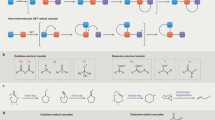Abstract
Free-radical chain reactions have been a mainstay of organic chemistry for many years due to the unique chemical behavior of highly reactive radical species. Recently, there has been a surge of interest in utilizing free-radical chain processes in the development of new synthetic methods for a variety of C–H functionalizations. Robust and reliable synthetic methods demand control, or at the very least, mediation of reactive species that are generated during radical chain processes. In the context of reaction optimization for intermolecular reactions, several recent experimental strategies for controlling the rates of radical initiation and propagation are discussed.














Similar content being viewed by others
Notes
For recent references that specifically note changes in reactivity between homogeneous and heterogeneous radical reactions see:
For seminal contribution, see:
For a review on direct radical additions to pharmaceutically relevant molecules, see:
For the first report of electrochemical initiation of metal-sulfinates see:
For an in-depth description of electrochemical/IR experimental setup see:
For a review on the persistent radical effect see
References
Minisci F, Vismara E, Morini G, Fontana F, Levi S, Serravalle M (1986) J Org Chem 51:476–479
Li Z, Wang Z, Zhu L, Tan X, Li C (2014) J Am. Chem. Soc 136:16439–16443
Suresh R, Kumaran RS, Senthilkumar V, Muthusubramanian S (2014) RSC Adv 4:31685–31688
Xia R, Xie MS, Niu HY, Qu GR, Guo HM (2014) Org Lett 16:444–447
Mai WP, Sun B, You LQ, Yang LR, Mao P, Yuan JW, Xiao YM, Qu LB (2015) Org. Biomol Chem 13:2750
Minisci F, Bernardi R, Bertini F, Galli R, Perchinummo M (1971) Tetrahedron 27:3575–3579
Minisci F (1973) Synthesis 1973:1–24
Minisci F, Vismara E, Fontana F (1989) Heterocycles 28:489–519
Minisci F, Fontana F, Vismara EJ (1990) Heterocycl Chem 27:79–96
Duncton MA (2011) J Med Chem Comm 2:1135–1161
Punta C, Minisci F (2008) Trends Heterocycl Chem 13:1–68
Seiple IB, Su S, Rodriguez RA, Gianatassio R, Fujiwara Y, Sobel AL, Baran PS (2010) J Am Chem Soc 132:13194–13196
Fujiwara Y, Domingo V, Seiple IB, Gianatassio R, Del Bel M, Baran PS (2011) J Am Chem Soc 133:3292–3295
Baxter RD, Liang Y, Hong X, Brown TA, Zare RN, Houk KN, Baran PS, Blackmond DG (2015) ACS Cent Sci 1:456–462
Langlois BR, Laurent E, Roidot N (1991) Tetrahedron Lett 32:7525–7528
Ji Y, Brückl T, Baxter RD, Fujiwara Y, Seiple IB, Su S, Blackmond DG, Baran PS (2011) Proc Natl Acad Sci USA 108:14411–14415
Fujiwara Y, Dixon JA, Rodriguez RA, Baxter RD, Dixon DD, Collins MR, Blackmond DG, Baran PS (2012) J Am Chem Soc 134:1494–1497
Fujiwara Y, Dixon JA, O’Hara F, Funder ED, Dixon DD, Rodriguez RA, Baxter RD, Herle B, Sach N, Collins MR, Ishihara Y, Baran PS (2012) Nature 492:95–99
O’Brien AG, Maruyama A, Inokuma Y, Fujita M, Baran PS, Blackmond DG (2014) Angew Chem Int Ed 53:11868–11871
O’Brien AG, Luca OR, Baran PS, Blackmond DG (2016) React Chem Eng 1:90–95
Zhou L, Tang S, Qi X, Lin C, Liu K, Liu C, Lan Y, Lei A (2014) Org Lett 16:3404–3407
Fischer H (2011) Chem Rev 101:3581–3610
Liu D, Li Y, Qi X, Liu C, Lan Y, Lei A (2015) Org Lett 17:998–1001
Huang Z, Zhang D, Qi X, Yan Z, Wang M, Yan H, Lei A (2016) Org Lett 18:2351–2354
Tang S, Liu K, Long Y, Qi X, Lan Y, Lei A (2015) Chem Commun 51:8769–8772
Author information
Authors and Affiliations
Corresponding author
Additional information
This minireview is dedicated to Professor Donna G. Blackmond on the occasion of her receiving the Gabor A. Samorjai Award for Creative Research in Catalysis from the American Chemical Society.
Rights and permissions
About this article
Cite this article
Mai, D.N., Baxter, R.D. Experimental Strategies for Controlling Radical Chain Reactions. Top Catal 60, 580–588 (2017). https://doi.org/10.1007/s11244-017-0734-z
Published:
Issue Date:
DOI: https://doi.org/10.1007/s11244-017-0734-z




